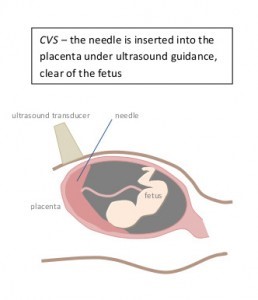What is Chorionic Villous Sampling (CVS)?
Chorionic Villous Sampling is a procedure that collects a small sample of placental tissue . The cells of the placenta have the same genetic material as the fetus and can therefore be tested for genetic abnormalities such as Down Syndrome.
Who is offered CVS?
If you are at a high risk for chromosome abnormalities, you may be offered testing by CVS, high risk categories include:
- Abnormal first trimester screen results
- Increased nuchal translucency or other abnormal ultrasound findings
- Family history of a chromosomal abnormality or other genetic disorder
- Parents are known carriers for a genetic disorder
- Advanced maternal age (maternal age above 37).
How is the test performed?
The test is performed at the ultrasound clinic by an Obstetrician Gynaecologist Sonologist (specialist ultrasound doctor).
The skin of the lower abdominal wall is cleansed with an antiseptic alcohol based solution. The skin and underlying tissues are injected with local anaesthetic. With ultrasound control, a fine needle is then guided into the placenta and a biopsy of placenta tissue (chorionic villi) is taken.
The needle itself is at all times well distanced from the baby. In fact when the biopsy is taken the needle is positioned outside the pregnancy sac.
When is the test performed?
Ideally the test is performed between 11 weeks 2 days and 13 weeks 5 days gestation.
What preparation do I need before the test?
You will need to bring:
- Referral from your doctor
- Reports for the pregnancy that were performed elsewhere
- Your blood group card
A moderate amount of fluid in the bladder is preferable. This can help make the uterus more accessible for the needle test.
How is the placental tissue analysed?
The specimen is sent to a laboratory to be processed. The tissue is placed in a culture medium and then into an incubator for several days. When there are sufficient numbers of dividing cells the specimen is removed from the incubator and the placental cells are split open with an enzyme. The individual chromosomes are counted and analysed.
Every cell should contain 23 pairs of chromosomes. As every pair is analysed, the results not only indicate the presence or absence of an extra chromosome number 21(Down Syndrome), but excludes chromosome abnormalities in the other 22 chromosome pairs.
In addition, each chromosome pair is stained with a special dye and examined under ultraviolet light. The individual bands of each chromosome are examined in great detail for subtle genetic abnormalities such as:
- Insertion of genetic material into a chromosome
- Deletion of genetic material from a chromosome and;
- Exchanging of genetic material between chromosomes (translocation).
This test excludes not only Down syndrome, but a wide variety of subtle and major chromosome abnormalities.
What should I do after the test?
It is advisable for someone to take you home after the test and that you rest for the remainder of the day. This does not mean you should confine yourself to bed but rather you should just rest at home and avoid any strenuous activity including lifting any heavy weights.
Most patients experience a short duration of mild crampy period-like pains. This is most likely to occur after the local anaesthetic wears off, ie. within the first half hour after the test. It is safe to take paracetamol or panadol.
It is not unusual for some patients to experience slight vaginal blood spotting after the test.
If the pains worsens or spotting progresses to fresh red bleeding, then contact your doctor.
What are the risks of the test?
There is a 1% risk of miscarriage with the test. This is usually related to infection introduced at the time of the procedure. Antiseptic precautions are taken to minimise this risk.
Warning signs of miscarriage include strong regular period like pains with fresh red bleeding. The time when miscarriage is most likely to occur is the first 24-48 hrs after the test. Contact your doctor should this occur.







